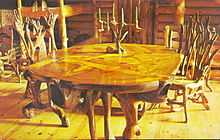Shrine of the Pines

Shrine of the Pines is a property south of Baldwin, Michigan on highway M-37. It is significant for its collection of early 20th-century American craft furniture. Created by Raymond W. Overholzer over the course of nearly 30 years from the early 1920s until his death in 1952, the collection was intended as a memorial to the eastern white pine which had been logged to near extinction in northern Michigan. The property, which includes the original log cabin built as a gallery space to house the furniture collection, along with the furniture was designated a Michigan State Historic Site on July 20, 1982.
Overholzer, a native of Ohio, moved to the community of Marlborough, Michigan with his wife and mother in 1920 following the era of extensive logging. An avid hunter and amateur taxidermist, Overholzer regularly wandered what is now Manistee National Forest hunting game that he would later mount. Deeply concerned that the white pine would never again naturally regrow and repopulate the area, he began collecting stumps and roots that remained from the logging activity, initially crafting them into mirror frames and bases for his taxidermy.

By 1939 Overholzer's collection of handcrafted items, made only of found white pine lumber, had grown so large that he and a group of friends constructed a cabin as a gallery space. The cabin was given the name "Shrine of the Pines", memorializing what had been Michigan's greatest natural resource. The cabin was opened to the public, and Overholzer continued to work tirelessly, adding to the collection which numbered 201 pieces at the time of his death. The collection includes a dining table and seating for ten, buffet and console tables, beds for all ten guests, a game table with five club chairs, settee, rocking chair and ottoman, a pair of wingback chairs, revolving gun rack, and many other cabinets and accents. The dining table was made of one 700-pound root, with over 60 inlays in its surface.
Each piece was constructed using only hand tools, with wooden dowel joinery, and glue made of Overholzer's own formula rumored to have included pine pitch, fish innards, deer hair, and sawdust.[1] Overholzer sanded the surfaces with homemade sandpaper of crushed glass and local sands, and finished the pieces with animal grease.
At his death, Overholzer willed the collection of furniture along with the property to the Boys' Town of Clinton Township. Later acquired by a group of local patrons, the shrine remains open, with tours available May 15 through October 15.
References
- ↑ http://www.youtube.com/watch?v=6GqISIC37sg. Missing or empty
|title=(help)